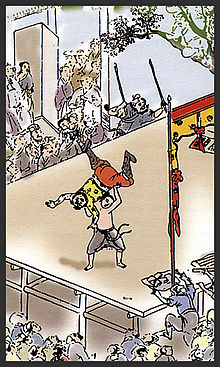This article needs additional citations for verification. (August 2015) |
| Lei tai | |||||||||||
|---|---|---|---|---|---|---|---|---|---|---|---|
 A fighter preparing to throw his opponent from the lei tai | |||||||||||
| Traditional Chinese | 擂臺 | ||||||||||
| Simplified Chinese | 擂台 | ||||||||||
| Literal meaning | striking platform | ||||||||||
| |||||||||||
The lei tai is an elevated fighting arena, without railings, where often fatal weapons and bare-knuckle martial arts tournaments were once held. "Sanctioned" matches were presided over by a referee on the platform and judges on the sides. Participants would lose if they surrendered, were incapacitated, or were thrown or otherwise forced from the stage. The winner would remain on the stage (as its "owner") unless ousted by a stronger opponent. If there were no more challengers, they would become the champion. Private duels on the stage had no rules and were sometimes fought to the death.
The lei tai first appeared in ancient China,[1] and in its present form during the Song dynasty.[2] However, ancient variations of it can be traced back to at least the Qin dynasty.[3] Today it is used in Sanshou[4] and Kuoshu[5] competitions throughout the world.
- ^ Cite error: The named reference
Brownellwas invoked but never defined (see the help page). - ^ [1] Archived September 2, 2006, at the Wayback Machine
- ^ "History". Kuoshu.co.uk. Retrieved 2015-08-12.
- ^ "San Shou Rules". Ikfkickboxing.com. Retrieved 2015-08-12.
- ^ [2] Archived December 26, 2008, at the Wayback Machine